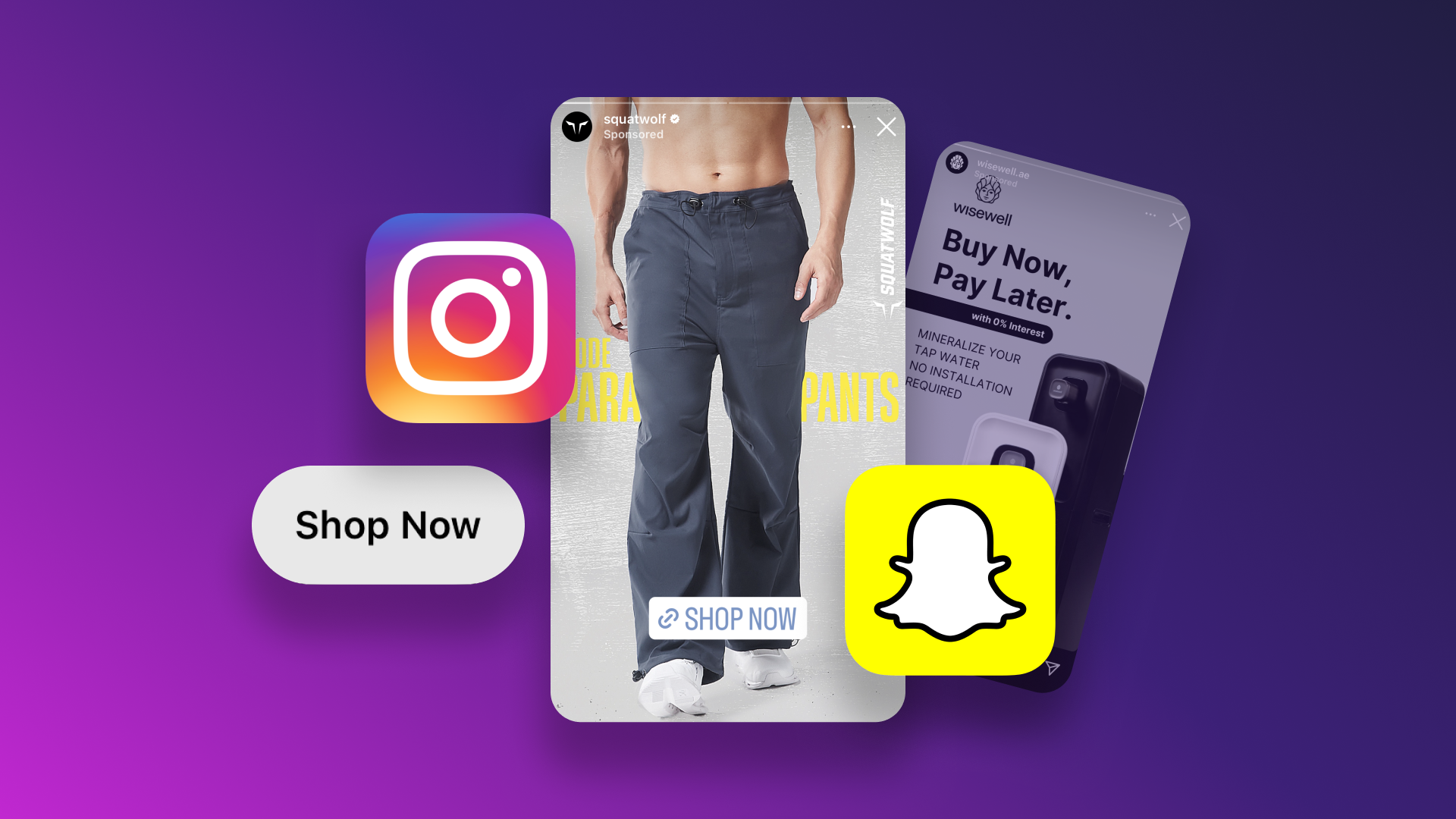Scared of social? Start with this simple guide
The Middle East has one of the highest social media adoption rates in the world. Read this guide to learn the basics of building a paid social media advertising strategy.

- What is Social Media Advertising?
- Choosing the Right Social Media Platforms
- Setting Advertising Goals and Objectives
- Creating a Compelling Ad Campaign
- Audience Targeting and Segmentation
- Budgeting and Ad Spend
- Ad Campaign Management
- Analytics
- Boost your ads with Tabby
What is Social Media Advertising?
Social media advertising is as simple as paying people to see your content on social media channels. When clicking through your Instagram stories or Snapchat, the ads you see come from brands paying the social media platform to access your feed.
Social media is vital for eCommerce brands as it often makes up a considerable proportion of their leads or sales.
Social media advertising is so effective for the following reasons:
- The ads are placed effectively where users are engaged.
- Targeting is available, which reduces the chance of showing ads to irrelevant shoppers.
- It’s easy for shoppers to share with friends.
- Shoppers can access your online store in just one click.
- Lots of different ad formats are available.
Setting Advertising Goals and Objectives
The first step when creating a social media advertising strategy is to set your core objectives.
What do you want to achieve by allocating marketing resources to social media advertising?
It’s best to define your objectives in the marketing funnel model, as this is used by social media platforms when you come to building your campaigns.

Choosing the Right Social Media Platforms
Choosing the right social media platform is the first step in targeting the right audience. Each platform has its own features and core user base.
To determine which platforms get you the best results, answer these questions.
- What is the demographic of your target market
All social media platforms have slightly different audiences. Don’t be caught out by the rumour that TikTok is exclusively for young people and Facebook is for the older generation. All platforms have different demographic trends, but targeting is more influential than the overall demographic regarding getting the right shoppers to see your ads. - Where are your competitors?
Your competitors have most likely done the research for you, especially if they have more experience in the industry. Look at their social media profiles and see which ones are active and well-engaged. - What resources do you have available to create content?
Each platform has a multitude of different ad placements. If you have a low level of creative resources, then it’s best to focus on placements that are easy to produce. For example, static graphics on Snapchat or self-shot videos for TikTok. Placements that require longer-form videos, such as YouTube, require more resources. - What are your marketing objectives?
All platforms can do top-of-funnel awareness well. When it comes to consideration, YouTube is excellent at being able to tell the story of your brand due to the longer (sometimes un-skippable) ad placements. Similarly, platforms such as TikTok and Instagram are built for engagement.
For more information, look at this comprehensive report on social media use in the MENA region.
Creating Compelling Ad Campaigns
Placement
The first thing to consider when creating your ads is the placement. Each platform has different guidelines depending on where your ad will be shown.
Check out this guide to see the details of different ad placements in depth.
Message
Decide the central message of your ad. Are you highlighting a USP or a specific campaign? Go back to your objective and use this to form the ad's main message.
Here are some examples of real Instagram story ads:

Creative
You're ready to create the ad once you have your message and placements. There are a few different ways to approach this.
Do it yourself
Gone are the days when every advert has to be a highly polished piece of content. Often, the best results come from self-shot photos and videos that feel raw and authentic. TikTok is an excellent platform to start with if you want to take this approach. You can hop on a popular trend or use an existing TikTok from your profile. Follow this advice to make authentic ads for TikTok.
Brief a designer
If you have a design team or a freelancer, then this is the time to brief what you need. Ensure to include the objectives, placements and message so the designer can produce something effective. If you need help designing, have a look at Ureed or Khamsat to get started.
If you’re struggling for inspiration, the best way to spark your creativity is to scroll through your social media feeds, taking particular notice of the ads you are being shown. Within a few minutes, you will have seen examples of how different brands approach social advertising.
Audience Targeting and Segmentation
One of the best things about spending your media budget on social advertising is the precision with which you can target your audience. Each platform comes with varying degrees of targeting by demographic. But also the ability to target shoppers based on their interests and interactions with the platform, which has proven valuable.
Retargeting
This is when you target your audience based on your previous interaction. The most common example of this is the Meta Pixel, a piece of code in your website that allows you to target your audience based on behaviour on your website. This is valuable because you can identify shoppers intending to buy, maximising the impact of your social ad campaigns. If you have an extensive customer email list, you can upload and target based on data like the number of purchases.
Look-a-like audiences
Meta’s ad platform can automatically create audiences most likely to interact with your ads. They analyse all the previous engagements your ads have had and build an audience that best resembles the attributes of those accounts. You can also create look-a-like audiences based on customer email lists you upload.
Look-a-like audiences can be very effective. Meta is building up a picture of your perfect customer and showing ads to them first.
Budgeting and Ad Spend
You can set lifetime budgets the platform will spend until it runs out. Or you can set daily budgets that won’t be exceeded. If you’re running a one-off campaign, using a lifetime budget is recommended, as it gives the platform more freedom to optimise. For regular, longer campaigns, it’s easier to control your budget with daily limits.
Bid strategy
Each platform is slightly different, but they all use some bidding system. Choose one that makes sense for your objectives.
- Highest volume
The budget is optimised for conversions. This is the most popular bidding strategy. - Highest value
This focuses your budget on high-value purchases or conversions, a good option for eCommerce brands with a higher price point. - Cost per result
This will allocate your budget to maintain the desired cost per result. This is used if you clearly know your cost per acquisition. - Return on ad spend
This will allocate the budget to maximise a direct amount of revenue. This is also popular for eCommerce brands if conversion means sales. - Bid cap
Manually set your bid budgets if you have a strong understanding of the advertising platform and confidence in your conversion rates.
Note: Each platform is slightly different. Before committing any spend, each platform will clearly outline how the budget will be allocated.
Ad Campaign Management
You must create an account on the appropriate platform to start building your campaigns.
Each platform will guide you through creating your first ad. This guide can help you add your creative, set your budget and choose your target audience.
The process does not stop after you launch your campaign. A vital part of ensuring that your social media ads are effective is monitoring each campaign's success and adjusting as you go. Make sure to spend more on well-performing ads and stop ads not delivering results.
Analytics
The success of your campaigns comes down to your core objectives, and you can track metrics accordingly.
Awareness and consideration
For campaigns that are focused on top-of-funnel metrics such as awareness or consideration. The analytics tools built into the platforms are sufficient. A vast list of metrics is tracked, including the most popular ones: total reach, click-through rates, cost per click, video retention rates, likes, and follows. Plenty of websites have attempted to benchmark what metrics make a good campaign. But proceed cautiously as results are wildly inconsistent based on industry and geography.
The best way to measure success is always to try and beat the metrics of your previous campaign, or if your budget is high enough, commission a broader brand study to find exactly how people are becoming aware of your brand and USPs.
Conversion
For eCommerce, the most popular metric to track is sales. You need to find out if your ads contribute to sales of the product displayed. This is where it gets a bit more complicated.
Imagine a scenario where a shopper is browsing TikTok on their lunch break. They see one of your beautifully engaging ads sandwiched between videos of someone dancing to the latest pop song. They click on your ad to find out more and make a mental note to buy your product when they get home from work. They return to their phone later that day when they’re on the couch watching Netflix, fill in their order details and make a purchase.
The ad they were served at lunch impacted the final purchase decision. But in a model where you just measure clicks and engagements, you do not know how effective your ads are. This is where Google Analytics becomes your best friend. Not only does it use UTM’s to track customer clicks on any of your ads before purchasing, but you can also track the performance from multiple platforms.
It also integrates with all major eCommerce platforms.
Boost your ads with Tabby
Retailers who use Tabby in their advertising often see an increase in results. No matter the size of your business, these options are available to all Tabby retailers.
Conversion
Display Tabby’s Pay in 4 option on your ad to decrease the shopper’s barrier to purchase. Show shoppers that the initial cost is more manageable to make your ad more effective.
Home Box incorporated Tabby in a paid social campaign and saw clicks increase by 23% and sessions by 11%. Overall, they saw a 23% increase in return on ad spend.
The Wisewell ad we have shown above also uses Tabby in their creative. They've seen a 19% reduction in cost per new customer as a result.
Brand awareness
Use Tabby’s status as a market-leading payment brand to instantly increase the trust of your ad. Associate your brand with Tabby to increase the effectiveness of your ads.
Access the Tabby Marketing Toolkit to start using Tabby in your ads.

